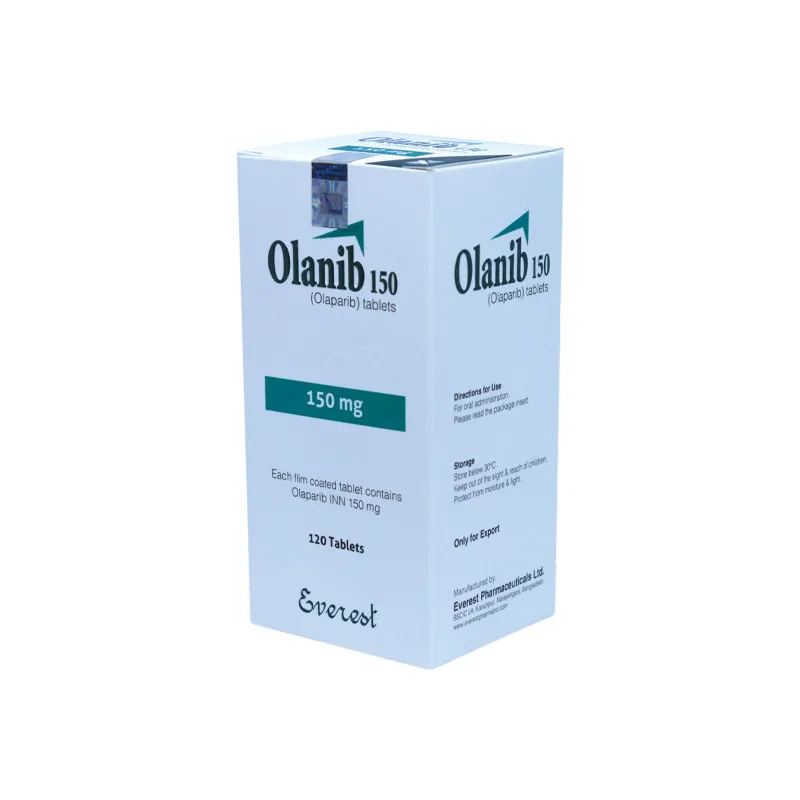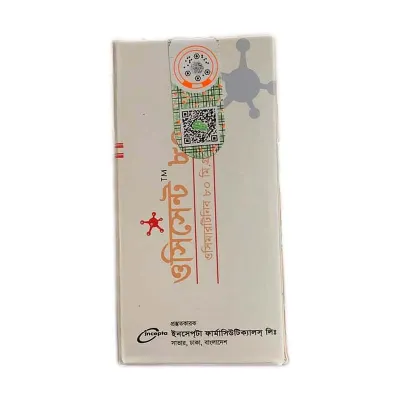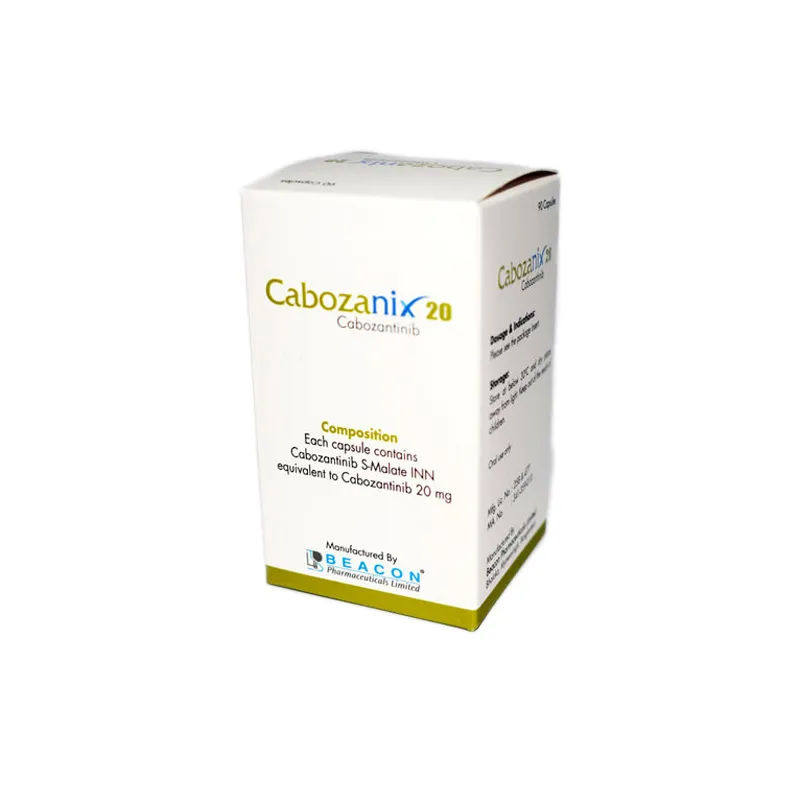Buy Olanib 150 mg (Olaparib)
Inquire UsDescription
What is Olanib 150 mg (Olaparib)?
Olanib 150 (Olaparib) tablets are used to help maintain the response of certain types of ovarian (female reproductive organs where eggs are formed), fallopian tube (tube that transports eggs released by the ovaries to the uterus), and peritoneal (layer of tissue that lines the abdomen) cancer in people who have completely responded or partially responded to their first or later chemotherapy treatments.
Olaparib tablets are also used to treat certain types of breast cancer that has spread to other parts of the body and has not improved or has worsened after treatment with other therapies.Olaparib tablets are also used to treat a certain type of prostate cancer that has spread to other parts of the body, no longer responds to medical or surgical treatments to lower testosterone levels, and has progressed after treatment with enzalutamide or abiraterone.
Olaparib tablets and capsules are also used to treat ovarian cancer that has not improved or has worsened after treatment with at least three other therapies. Olaparib tablets are also used to help maintain the response of a certain type of pancreatic cancer that has not spread or progressed after the first chemotherapy treatment. Olaparib is a polyadenosine 5′-diphosphoribose polymerase (PARP) enzyme inhibitor. It works by killing cancer cells. Source: MedlinePlus
Why should you buy the generic Olanib online?
First of all generic Olanib is very affordable version of olaparib for advanced ovarian cancer patients. It is a verified generic version of Lynparza. Everest pharmaceuticals Limited manufacture this generic version in Bangladesh. It is one of the renowned pharmaceutical companies who mostly made cancer medicine in Bangladesh. After the Directorate General of Drug Administration of Bangladesh approves to manufacture olaparib, they started to make it and sell it all over the world where generic medicine is allowed to use.
It is the first generic version of Lynparza which is selling regularly all over the world. It is also 92% cheaper than the brand version of olaparib. Which cost you less than 600 dollars.
COMPOSITION
Olanib 150 Tablet: Each flim coated tablet contains Olaparib INN 150 mg.
INDICATIONS AND USAGE OF OLANIB
Olaparib is a poly (ADP-ribose) polymerase (PARP) inhibitor indicated as monotherapy in patients with deleterious or suspected deleterious germ line BRCA mutated (as detected by an FDA-approved test) advanced ovarian cancer who have been treated with three or more prior lines of chemotherapy.
DOSAGE AND ADMINISTRATION
The recommended dose of Olaparib is 300 mg (two 150 mg tablets) taken twice daily, equivalent to a total daily dose of 600 mg. It is recommended that treatment be continued until progression of the underlying disease or unacceptable toxicity. Patients with platinum-sensitive relapsed (PSR) high-grade epithelial ovarian, fallopian tube, or primary peritoneal cancer who are in response (complete or partial) to platinum-based chemotherapy should start treatment with Olaparib no later than 8 weeks after completion of their final dose of the platinum-containing regimen.
Important differences in posology between Olaparib tablets and capsules
Olaparib tablets (100 mg and 150 mg) should not be substituted for Olaparib capsules (50 mg) on a milligram-to-milligram basis due to differences in the dosing and bioavailability of each formulation. Therefore, the specific dose recommendations for each formulation should be followed.
Missing dose
If a patient misses a dose of Olaparib, they should take their next normal dose at its scheduled time.
Dose adjustments for adverse reactions
Treatment may be interrupted to manage adverse reactions such as nausea, vomiting, diarrhoea, and anaemia and dose reduction can be considered. The recommended dose reduction is to 250 mg twice daily (equivalent to a total daily dose of 500 mg). If a further dose reduction is required, then reduction to 200 mg twice daily (equivalent to a total daily dose of 400 mg) is recommended.
Dose adjustments for co-administration with CYP3A inhibitors
Concomitant use of strong or moderate CYP3A inhibitors is not recommended and alternative agents should be considered. If a strong CYP3A inhibitor must be co-administered, the recommended Olaparib dose reduction is to 100 mg taken twice daily (equivalent to a total daily dose of 200 mg). If a moderate CYP3A inhibitor must be co-administered, the recommended Olaparib dose reduction is to 150 mg (one 150 mg tablet) taken twice daily (equivalent to a total daily dose of 300 mg).
Special populations
Elderly
No adjustment in starting dose is required for elderly patients. There are limited clinical data in patients aged 75 years and over.
Renal impairment
For patients with moderate renal impairment (creatinine clearance 31 to 50 ml/min) the recommended dose of Olaparib is 200 mg twice daily (equivalent to a total daily dose of 400 mg).
Olaparib can be administered in patients with mild renal impairment (creatinine clearance 51 to 80 ml/min) with no dose adjustment. Olaparib is not recommended for use in patients with severe renal impairment or end-stage renal disease (creatinine clearance 30 ml/min), as safety and pharmacokinetics have not been studied in these patients.
Olaparib may only be used in patients with severe renal impairment if the benefit outweighs the potential risk, and the patient should be carefully monitored for renal function and adverse events.
Hepatic impairment
Olaparib can be administered to patients with mild or moderate hepatic impairment (Child-Pugh classification A or B) with no dose adjustment. Olaparib is not recommended for use in patients with severe hepatic impairment (Child-Pugh classification C), as safety and pharmacokinetics have not been studied in these patients.
Method of administration Olaparib is for oral use.
Olaparib tablets should be swallowed whole and not chewed, crushed, dissolved or divided. Olaparib tablets may be taken without regard to meals.
CONTRAINDICATIONS
Hypersensitivity to Olaparib or to any of the excipients.
WARNINGS AND PRECAUTIONS
Myelodysplastic Syndrome/Acute Myeloid Leukemia Myelodysplastic Syndrome/Acute Myeloid Leukemia
(MDS/AML) have been confirmed in 6 out of 298 (2%) patients enrolled in a single arm trial of Olaparib monotherapy, in patients with deleterious or suspected deleterious germline BRCA-mutated (gBRCAm) advanced cancers. In a randomized placebo controlled trial, MDS/AML occurred in 3 out of 136 (2%) patients with advanced ovarian cancer treated with Olaparib. Overall, MDS/AML were reported in <1% patients treated with Olaparib in clinical studies.
The majority of MDS/AML reports were fatal, and the duration of therapy with Olaparib in patients who developed secondary MDS/ cancer- therapy related AML varied from <6 months to >2 years. All of these patients had previous chemotherapy with platinum agents and/or other DNA damaging agents including radiotherapy. Some of these patients also had a history of previous cancer or of bone marrow dysplasia.
Monitor complete blood count testing at baseline and monthly thereafter. Do not start Olaparib until patients have recovered from hematological toxicity caused by previous chemotherapy (CTCAE Grade 1). For prolonged hematological toxicities, interrupt Olaparib and monitor blood counts weekly until recovery. If the levels have not recovered to CTCAE Grade 1 or less after 4 weeks, refer the patient to a hematologist for further investigations, including bone marrow analysis and blood sample for cytogenetics. If MDS/AML is confirmed, discontinue Olaparib.
SIDE EFFECTS
Most common adverse reactions (>20%) in clinical trials were anemia, nausea, fatigue (including asthenia), vomiting, diarrhea, dysgeusia, dyspepsia, headache, decreased appetite, nasopharyngitis/pharyngitis/ URI, cough, arthralgia/musculoskeletal pain, myalgia, back pain, dermatitis/ rash and abdominal pain/discomfort.
Most common laboratory abnormalities (>25%) were increase in creatinine, mean corpuscular volume elevation, decrease in hemoglobin, decrease in lymphocytes, decrease in leucocytes, decrease in absolute neutrophil count, and decrease in platelets.
DRUG INTERACTIONS
Anticancer Agents
Clinical studies of Olaparib in combination with other myelosuppressive anticancer agents, including DNA damaging agents, indicate a potentiation and prolongation of myelosuppressive toxicity.
Drugs that may Increase Olaparib Plasma Concentrations Olaparib is primarily metabolized by CYP3A. Avoid concomitant use of strong CYP3A inhibitors (e.g., itraconazole, telithromycin, clarithromycin, ketoconazole, voriconazole, nefazodone, posaconazole, ritinovir, lopinavir/ritinovir, indinavir, saquinavir, nelfinavir, boceprevir, telaprevir) and moderate CYP3A inhibitors (e.g., amprenavir, aprepitant, atazanavir, ciprofloxacin, crizotinib, darunavir/ritonavir, diltiazem, erythromycin, fluconazole, fosamprenavir, imatinib, verapamil).
If the strong or moderate CYP3A inhibitors must be co-administered, reduce the dose of Olaparib. Avoid grapefruit and Seville oranges during Olaparib treatment.
Drugs that may Decrease Olaparib Plasma Concentrations
Avoid concomitant use of strong CYP3A inducers (e.g., phenytoin, rifampicin, carbamazepine, St. John’s Wort) and moderate CYP3A4 inducers (e.g., bosentan, efavirenz, etravirine, modafinil, nafcillin). If a moderate CYP3A inducer cannot be avoided, be aware of a potential for decreased efficacy of Olaparib.
USE IN SPECIFIC POPULATIONS
Pregnancy
Pregnancy category is D. Olaparib can cause fetal harm when administered to a pregnant woman based on its mechanism of action and findings in animals. Olaparib was teratogenic and caused embryo-fetal toxicity in rats at exposures below those in patients receiving the recommended human dose of 300 mg twice daily. If this drug is used during pregnancy, or if a patient becomes pregnant while taking this drug, apprise the patient of the potential hazard to the fetus and the potential risk for loss of the pregnancy.
Nursing Mothers
It is not known whether Olaparib is excreted in human milk. Because many drugs are excreted in human milk and because of the potential for serious adverse reactions in nursing infants from Olaparib, a decision should be made whether to discontinue nursing or to discontinue the drug, taking into account the importance of the drug to the mother.
Populations With Reproductive Potential
Pregnancy testing is recommended for females of reproductive potential prior to initiating treatment with Olaparib. Olaparib can cause fetal harm when administered to a pregnant woman. Advise females of reproductive potential to use highly effective contraception during treatment with Olaparib and for at least 6 months following the last dose.
Pediatric Use
The safety and efficacy of Olaparib has not been established in pediatric patients.
Geriatric Use
In clinical studies it was found that the safety profile was similar irrespective of age with the exception of AEs of CTCAE >3 which were reported more frequently in patients aged >65 years (53.4%) than those <65 years (43.4%). No individual adverse event or System Organ Class accounted for this observed difference.
Hepatic Impairment
No adjustment to the starting dose is required in patients with mild hepatic impairment. A 1.2-fold increase in mean exposure (AUC) of Olaparib was observed in patients with mild hepatic impairment (based on Child-Pugh classification A) compared to patients with normal hepatic function. There are no data in patients with moderate or severe hepatic impairment.
Renal Impairment
No dose adjustment to the starting dose is required in patients with mild renal impairment, but patients should be monitored closely for toxicity. For patients with moderate renal impairment, reduce the dose of Olaparib to 200 mg twice daily (please see Dosage and Administration). There are no data in patients with severe renal impairment or end-stage disease (CLcr 30 mL/min).
OVERDOSAGE
There is no specific treatment in the event of Olaparib overdose, and symptoms of overdose are not established. In the event of an overdose, physicians should follow general supportive measures and should treat symptomatically.
CLINICAL PHARMACOLOGY
Mechanism of Action
Olaparib is an inhibitor of poly (ADP-ribose) polymerase (PARP) enzymes, including PARP1, PARP2, and PARP3. PARP enzymes are involved in normal cellular homeostasis, such as DNA transcription, cell cycle regulation, and DNA repair. Olaparib has been shown to inhibit growth of select tumor cell lines in vitro and decrease tumor growth in mouse xenograft models of human cancer both as monotherapy or following platinum-based chemotherapy. Increased cytotoxicity and anti-tumor activity following treatment with Olaparib were noted in cell lines and mouse tumor models with deficiencies in BRCA. In vitro studies have shown that Olaparib-induced cytotoxicity may involve inhibition of PARP enzymatic activity and increased formation of PARP-DNA complex, resulting in disruption of cellular homeostasis and cell death.
Pharmacokinetics
Absorption
Following oral administration of Olaparib via the capsule formulation, absorption is rapid with peak plasma concentrations typically achieved between 1 to 3 hours after dosing. On multiple dosing there is no marked accumulation (accumulation ratio of 1.4 — 1.5 for twice daily dosing), with steady state exposures achieved within 3 to 4 days.
Distribution
Olaparib had a mean (± standard deviation) apparent volume of distribution at steady state of 167 ± 196 L after a single 400 mg dose of Olaparib. The in vitro protein binding of Olaparib at plasma concentrations achieved following dosing at 300 mg twice daily is approximately 82%.
Metabolism
In vitro, CYP3A4 was shown to be the enzyme primarily responsible for the metabolism of Olaparib. The majority of the metabolism is attributable to oxidation reactions with a number of the components produced undergoing subsequent glucuronide or sulfate conjugation.
Excretion
A mean (± standard deviation) terminal plasma half-life of 11.9 ± 4.8 hours and apparent plasma clearance of 8.6 ± 7.1L/h were observed after a single 300 mg dose of Olaparib.
Drug Interactions
In vitro studies have shown that Olaparib is both an inhibitor and inducer of CYP3A and an inducer of CYP2B6. Simulations suggested that Olaparib may not affect the exposure of a CYP3A substrate in humans. It cannot be excluded that Olaparib may induce CYP2C9 and CYP2C19. In vitro studies also indicated that Olaparib is a substrate of P-gp and an inhibitor of P-gp (MDR1), BCRP, OATP1B1, OCT1, OCT2, OAT3, MATE1 and MATE2K. The clinical relevance of these findings is unknown. The potential for Olaparib to induce P-gp has not been evaluated.
Pharmacokinetics in Specific Populations
Hepatic Impairment
In a hepatic impairment trial, the mean AUC increased by 15% and the mean Cmax by 13% when Olaparib was dosed in patients with mild hepatic impairment (Child-Pugh classification A; N=9) compared with patients with normal hepatic function (N=13). Mild hepatic impairment had no effect on the protein binding of Olaparib and therefore total plasma exposure was representative of free drug. There are no data in patients with moderate or severe hepatic impairment.
Renal Impairment
In a dedicated renal impairment trial, the mean AUC and C. of Olaparib both increased by 1.2-fold, when Olaparib was dosed in patients with mild renal impairment (CLcr = 51-80 mL/min defined by the Cockcroft-Gault equation; N=13) and by 1.4- and 1.3-fold, respectively, when Olaparib was dosed in patients with moderate renal impairment (CLcr = 31-50 mL/min; N=13), compared to those with normal renal function (CLcr >81 mL/min; N=12). There was no evidence of a relationship between the extent of plasma protein binding of Olaparib and creatinine clearance. There is no data in patients with severe renal impairment or end-stage renal disease (CLcr 30 mL/min).
PHARMACEUTICAL INFORMATION
Storage Conditions
Store in a cool and dry place. Store below 30°C. Do not take Olaparib 150 mg tablet if it is suspected of having been exposed to temperatures greater than 40°C or 104°F. Keep the bottle out of the reach and sight of children.
HOW SUPPLIED
Olanib 150 Tablet: Each HDPE container contains 120 tablets, each of which contains Olaparib INN 150 mg.
Buy Olanib 150 mg Online
Are you interested to purchase Olanib 150 mg online? Don’t worry. 100 Meds can help you to find reliable and verified medicine at affordable cost. Please contact our support team by using email, whatsapp or wechat. Even you can contact our facebook page.
You must be logged in to post a review.






Reviews
There are no reviews yet.